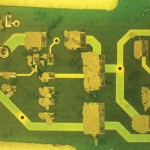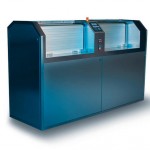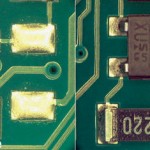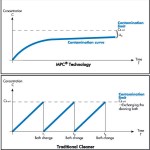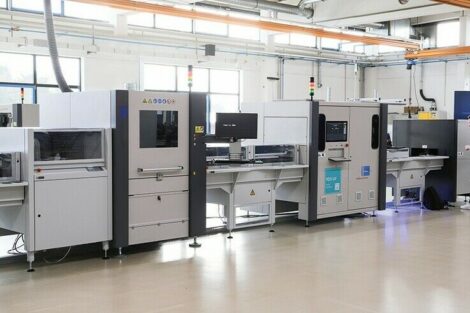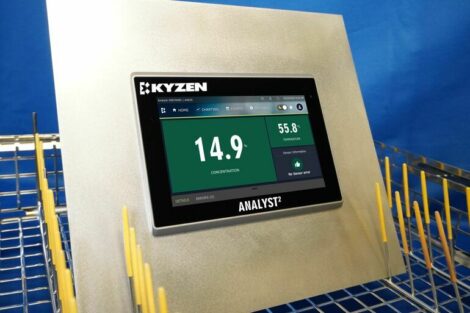By introducing an optimized cleaning process, Marquardt was able to realize the cleaning of their stencils and misprinted PCBs in a single process. Solder pastes, SMT adhesives as well as flux residues can now be removed in a single cleaning process. Due to cleaning the double-sided, populated PCBs, of which some have already been soldered on one side, they can be reintroduced into the production process. The company has thereby reduced rejects to a minimum and lowered production costs.
Marquardt GmbH headquartered in Rietheim-Weilheim has been manufacturing switches and accessories for the electronics industry for over 80 years. With more than 4,000 employees, the “specialist in electronics and precision engineering” has emerged as an international corporate group with production facilities in Europe, Africa, Asia and America. As one of the most innovative developers and manufacturers of switches and switching systems for numerous branches of industry, the family-owned company generated 470 million euros in earnings last year. The decisive factor in the continued growth of the corporate group during the past years was and remains innovation. The company invests more than seven percent of its yearly earnings into research and development of new products. Product offering expansion together with a higher need for stencil cleaning cycles increased the demands on the cleaning process. As a result, in 2006 the decision was made at the facility in Rietheim to purchase a new system to clean SMT stencils and misprints.
Requirements for the cleaning process
In addition to stencils contaminated with solder paste and SMT adhesive, the planned cleaning process should also be suitable for cleaning misprinted PCBs (figure 1). Marquardt not only wished to remove the solder paste residues or SMT adhesive from the misprinted PCBs, but also to remove flux residues from the soldering process on the already populated and soldered side (figure 2). However, the removal of the flux on the soldered side is a challenge since conventional stencil cleaning agents frequently produce unsatisfactory results. Often, so called “white residues” remain on the PCBs, which can cause problems in the field (such as electrochemical migration, corrosion and coating malfunctions) under certain climatic conditions. The cleaning medium and process must therefore be tailored to the demands of cleaning misprints. The advantage of such a process is that misprinted boards, which are already soldered on one side, do not have to be discarded but can be reintroduced into the process. This lowers overall production costs.
Selecting the cleaning process
To define the right equipment matching the production process and requirements, Marquardt determined the throughput. Thereby, it was found that stencils from the 6 SMD lines comprised the largest percentage of the throughput. These are cleaned between 1 to 4 times per shift which yields at a minimum 18 up to 72 cleaning cycles per day in three-shift operation. In addition to these stencils there are the unsoldered misprinted boards and the misprints with one soldered side. The requirements of the cleaning process were therefore defined by the parts to be cleaned. Solder paste, SMT adhesive and flux residues needed to be removed in a single process. Furthermore, the manufacturer set a high value on reducing drag out and hence consumption during the process. It also made strict demands concerning safety at work. A water-based cleaning medium was preferred, which has no flashpoint due to its physical properties and is easier to store and safer to handle in comparison to a solvent-based cleaning agent. Furthermore, the cleaning agent should not contain any hazardous materials.
Concerning efficiency, the cleaning agent also had to have a high bath loading capacity and hence long bath life times lowering the overall cost. After all the essential features of the new cleaning process were established, different cleaning machines and media were tested. In Zestron’s Technical Center, cleaning trials were conducted in single and multiple-chamber spray-in-air, ultrasonic and spray-under-immersion cleaning machines with various water-based cleaning agents. The choice was finally made for a Systronic CL 500 three-chamber spray-in-air cleaning machine together with the water-based microphase cleaning agent Vigon SC 202, since this process met the special requirements best (figure 3).
The cleaning process in practice
Depending on the parts to be cleaned, a specific program saved in the SPC controller of the system is started. The cleaning agent is pumped from the supply tank and sprayed onto the stencils or PCBs by means of rotating spray arms. The cleaning occurs in a closed loop process. Cleaning is followed by the so-called “drain-off time” to allow the cleaning medium to return to the supply tank. Guided by an automatic conveyer system, the cleaned parts are taken through the rinsing into the drying chamber. While being transported through the rinsing chamber, the stencils and assemblies pass between fixed sets of nozzles. The cleaning agent and any adhering residual particles are rinsed off. The substrate is dried quickly with hot air being conveyed by a cross-flow fan.
As described, the cleaning machine has separate chambers for cleaning, rinsing and drying. This three-chamber cleaning process only allows the cleaning agent on the cleaned parts (stencils or PCBs) to be dragged over from the cleaning to the rinsing chamber. The cleaning agent on the chamber walls, pipes and pumps remains in the cleaning chamber and is not rinsed off. The cleaning and rinsing medium are thereby separated optimally. In comparison to cleaning machines with just one processing chamber, the consumption of the cleaning agent tends to be less in the three-chamber system. In addition to the lower consumption of cleaning medium, the rinse water treatment is also much more cost effective since less cleaning agent is rinsed off. Therefore, the three-chamber process convinced the manufacturer with a lower overall cost. As mentioned, drying occurs in a separate chamber. This allows two stencils to be cleaned simultaneously in the system, thus enabling the higher throughput anticipated by Marquardt in the future. Moreover, separating the cleaning and drying chamber prevents drying the walls of the cleaning chamber. Only the cleaned parts are dried which also reduces consumption.
The water-based cleaning medium completes the stencil and misprint cleaning process. The slight alkalinity of the cleaning agent especially designed for cleaning misprints reliably removes solder paste and SMT adhesives from stencils as well as flux residues from misprinted assemblies (figure 4). The cleaning agent is based on the MPC technology, which removes impurities from the surface using microphases. Subsequently, these microphases release the contamination to the surrounding aqueous phase, so that it can then be filtered. The filters in the cleaning machine remove the residues from the system permanently. Due to this continuous regeneration of the cleaning agent, very long bath life times in comparison to conventional cleaning agents are achieved (figure 5). This in turn decreases overall process costs. The requirements regarding safety at work and storage are also met by the water-based process. The cleaning agent does not contain any hazardous materials, is not flammable, and thereby assures optimum working and storage conditions. Overall, optimal cleaning results were achieved with the new process, and all of Marquardt’s requirements were successfully met.
Conclusion
The three-chamber cleaning process has proved to be particularly economical due to the reduced drag out of cleaning agent and minimal evaporation loss. Contaminants such as solder paste, SMT adhesives and flux residues are completely removed by a modern, water-based cleaning agent. The close collaboration between the customer, machine manufacturer and chemical supplier before implementing the cleaning process allowed a process to be developed, which optimally met all of the manufacturer’s demands regarding efficiency and overall cleaning costs.
EPP Europe 439
zusammenfassung
Die Fallstudie zeigt, wie die Firma Marquardt in einem innovativen Reinigungsprozess neben Schablonen auch ihre fehlbedruckten Leiterplatten reinigen kann. Der Reinigungsprozess ermöglicht es, die zweiseitig bestückten und zum Teil bereits einseitig gelöteten Baugruppen wieder der Produktion zuzuführen. Die Firma schaffte es auf diese Weise, den Ausschuss zu minimieren und die Produktionskosten zu senken.
L’étude de cas montre qu’un processus de nettoyage innovant permet à la société Marquardt de nettoyer, outre les pochoirs, les circuits qui n’ont pas été correctement imprimés. Le processus de nettoyage permet de réintroduire dans la production les composants équipés des deux côtés et déjà partiellement soudés sur une face. L’entreprise est ainsi parvenue à réduire les chutes ainsi que les coûts de production.
Il caso studio mostra come la ditta Marquardt sia in grado di pulire non solo gli stencil ma anche i circuiti stampati non correttamente grazie ad un processo innovativo. Il processo di pulitura consente reintrodurre nella produzione i gruppi costruttivi con componenti su due lati e già saldati su un lato. L’azienda riesce così a ridurre gli scarti e i costi di produzione.
Share:


